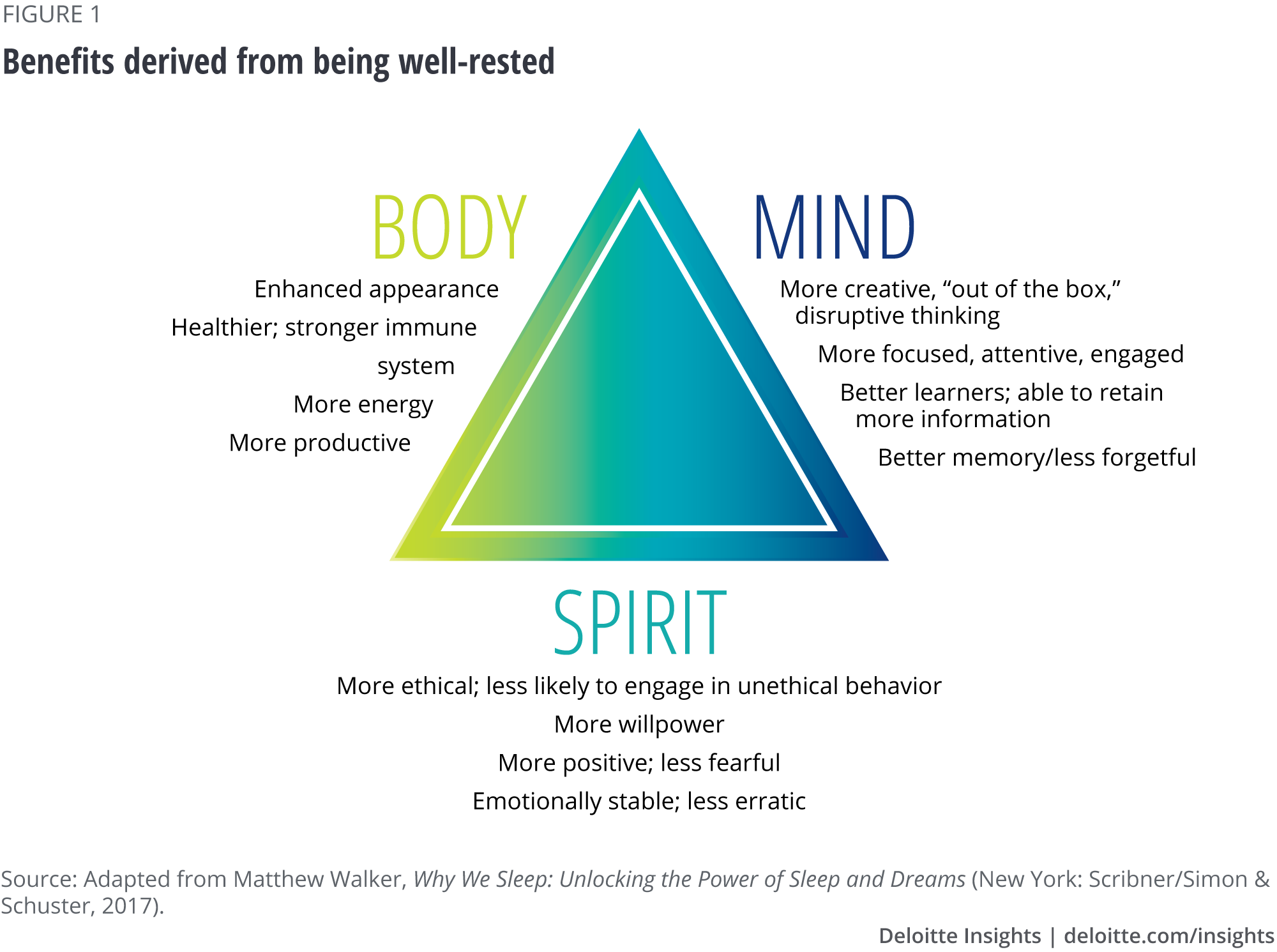
You snooze, you win Why organizations should prioritize having a well-rested workforce
9 minute read
04 February 2019
Is sleep a business issue? Sure, getting a good night’s sleep increases well-being, but it can also boost productivity and creativity and help foster innovation. Learn how organizations can create an environment that puts sleep first.
Organizations often devote significant resources to upskill their workforce, through internal and external training opportunities. They also spend quite a lot of time, attention, and money trying to identify sources of competitive advantage. However, these organizations may be overlooking a powerful way to potentially upskill and gain competitive advantage, which could be accessed much more readily, and at far less expense, than broad-scale training and innovation initiatives: having a well-rested workforce.
Our “always-on” society: When something’s got to give, often it is sleep
Learn More
Explore the Behavioral economics & management collection
Subscribe to receive related content
Download the Deloitte Insights app
While the topic of sleep has garnered a lot of attention in recent years, so far, many organizations haven’t focused much on reinforcing the importance of a good night’s sleep—or creating what we call a “sleep-first” culture. Existing cultural norms and perceptions, coupled with the use and ubiquity of the latest technologies, continue to undermine employees’ ability to get good quality sleep.
In this article, we explore the benefits of sleep along with the adverse consequences of not getting enough sleep. Specifically, we focus on how having a sleep-deprived workforce can undermine performance and may represent a huge missed opportunity for organizations. We leave our readers with practical suggestions regarding how to turn the tide and create a culture that encourages, and even rewards, sleep.
The reasons why most people don’t get enough sleep are fairly obvious. Technological advances, globalization, and increased competitive threats have contributed to the fast-paced, 24/7, “always-on” environment we experience today. People experience this in their personal lives outside of work (for example, headline news updates) and also in their careers. As organizations increasingly expand their operations across continents, there are more and more multinational teams. This often results in individuals working late nights or early mornings. Exacerbating this situation is the increase in competitive threats from both incumbents and disruptors, which puts pressure on companies—and their workforces—to stay on top of things while challenged by constant change. In this fast-paced, high-stakes environment, clearly something has got to give, and so often, what ends up being sacrificed is sleep.
The negative impact of having a sleep-deprived workforce
In the short term, putting sleep on the back burner may help employees hit their deadlines, but it is likely a poor—and possibly dangerous—long-term strategy. A substantial amount of research has found that sleep is critical to overall performance and well-being. A lack of sleep has a direct, negative impact on a person’s body, mind, and spirit, also affecting emotions, temperament, and self-control. Additionally, chronic sleep deprivation has been linked to many leading health issues, such as heart disease, obesity, dementia, diabetes, and cancer.1 A study of competitive young athletes found that a chronic lack of sleep resulted in a greater likelihood of injury; athletes averaging six hours per night had a greater than 70 percent chance of injury, while those who slept an average of nine hours had less than a 20 percent chance of injury.2 It also doesn’t take a lot of missed sleep to lead to an adverse effect: A study conducted on young, fit, and otherwise healthy individuals found that even one night of reduced sleep—as little as a one-hour or two-hour reduction—resulted in increased heart rates and higher blood pressure.3
From an organizational perspective, a lack of sleep often has a direct impact on workplace performance. People’s ability to learn, concentrate, and retain information is greatly impacted by how well-rested they are.4 Insufficient sleep causes individuals to be more emotionally unstable, or moody, and has been tied to aggression and forgetfulness.5 Preliminary research also suggests that individuals who lack sufficient sleep are more prone to unethical behavior.6 These factors can yield negative consequences for organizational teamwork and individual performance.
For organizations, it’s not just about what might be lost, but about what could be missed out on from a lack of sleep—the untapped potential that can be gained from having a well-rested workforce. Most companies go to great lengths to identify high-performing potential candidates and train employees on new ways to “think outside of the box” and be innovative. While these efforts may be focused on boosting productivity, they can also help firms identify new innovative products and services to give them a competitive edge, and ideally disrupt the marketplace. Although there may not be a magic bullet to enhance employee performance, what if having well-rested employees was the next best thing?
Sleep as the ultimate performance enhancer
When we think about “performance enhancers,” what often comes to mind are images of athletes who have tried to get an edge utilizing some form of—often illegal—performance-enhancing substance, such as steroids. While we hope these substances are not prevalent in most workplaces, many employees rely on legal stimulants such as coffee and tea to get them through the day, which are often free to employees and readily accessible on every work floor.
Beyond reportedly enhancing one’s learning, memory, and retention, and lessening the risk of disease or injury, sufficient sleep generally makes people more relaxed, less anxious, appear more attractive, and it lowers food cravings. Moreover, and perhaps of most interest to organizations, increased sleep tends to cause individuals to be happier, more engaged, and more creative. Sleep may, in fact, be the ultimate performance enhancer—one that reinforces good health instead of sacrificing it, as caffeine and other drugs do.
However, worth noting, it isn’t just the quantity of sleep but rather the quality and consistency that should be considered. Most of the sleep research seems to agree that “catching up” on sleep over the weekend or during vacation is a myth: Ten hours of sleep one night does not fully make up for getting just six the night before. And while naps can be a good band-aid and do provide some positive effects in terms of memory consolidation,7 to reap the full benefits of sleep, people should engage in consistent, non-drug- or alcohol-induced sleep for ideally seven to nine hours.8 Uninterrupted sleep enables both NREM (nonrapid eye movement) sleep for learning and retention and REM (rapid eye movement) sleep for creativity to occur. In fact, a good night’s sleep has been found to be an ideal form of therapy; it can help people deal with, manage, and sort out emotions. It even has the potential to reduce some cognitive biases, such as fear and negativity (see figure 1).
During REM sleep dreaming, the human mind can achieve a heightened state of creativity, enabling people to connect disparate memories, ideas, or information in new and powerful ways. In fact, REM sleep dreaming has led to some remarkable accomplishments: The Beatles’ songs “Yesterday” and “Let it be” first came to Paul McCartney in his dreams,9 and Russian chemist and inventor Dmitri Mendeleev created the periodic table of elements—the comprehensive constituent building blocks of nature—while dreaming.10 This informational “daisy-chaining” as Dr. Matthew Walker refers to it in his book, Why We Sleep, is a key differentiator between the human brain and a computer. While computers may be able to store an enormous number of individual files, standard computers cannot “intelligently interlink” those files in numerous and creative combinations.11 But human memories are interconnected in webs of associations that lead to flexible, potentially “predictive powers,” thanks in large part to REM sleep and dreams.12 Thus, it may be REM sleep and dreams—and our ability to connect seemingly disparate pieces of information into something meaningful and whole—that may give workers a competitive advantage over machines.13

Steps to promote a sleep-first, then-work culture
So, just how can companies turn the tide, and encourage employees to turn up the covers instead of burning the candle at both ends? Below, and summarized in figure 2, are a number of tactics organizations can use to help foster a sleep-first culture.14 While it may not be possible to implement all of these ideas, even adding a few would likely help.
Environmental steps
Provide workspaces that offer ample natural light. Emphasize natural light in work environments and give workers the ability to adjust the light in their environment, if possible, based on the available office space.
Offer nap rooms. Provide nap rooms or alternative spaces with comfortable furniture and blankets so employees can rest during the workday. Some nap rooms are equipped with “dawn simulators” instead of alarm clocks, which awaken users by gently increasing levels of light and sound.15 Consider providing the option of aromatherapy in these rooms,16 as certain scents, such as lavender, have been found to help induce sleep.17
Provide easy access to water and affordable, healthy food options. Consider limiting access to caffeinated beverages to only in the morning.
Rewards and incentives
Provide educational programs on sleep. For organizations requiring employees to partake in continuing education, these programs could count toward training credits.
Create programs that incentivize sleep.18 Aetna pays its employees a little more than US$1 for every night they get seven or more hours of sleep.19 As Aetna’s CEO Mark Bertolini stated, “Being present in the workplace and making better decisions has a lot to do with our business fundamentals.” He explained, “You can’t be prepared if you’re half asleep.” Since implementing the policy, Aetna has measured an uptick in worker productivity by 69 minutes per month.20
Technology and policy
Reduce after-hours emails.21 Limit or disable employees’ ability to send or receive emails after business hours within their geography. Alternatively, firm leaders can create a company policy that limits sending after-hours emails. France recently passed a law requiring businesses with more than 50 employees to establish policies with hours during which employees can’t send or respond to emails. Other companies are following suit by limiting after-hours email use.22
Disable or discourage after-hours video or Skype calls. To eliminate the LED/blue glow wakefulness effect of computer screens, set up technology to default to audio only for after-hours. For global calls that must happen outside of normal regional work hours, encourage those taking calls outside of their region’s office hours to only use their phones instead of taking the call on their computers.
Behavioral nudges
Drawing from behavioral science, organizations can leverage the following tactics to encourage changes in habits among employees:
Use commitment devices, such as a sleep pledge. Research has found that when individuals publicly and explicitly commit to a specific course of action, they are more likely to follow through.23 With this in mind, consider having employees take a sleep pledge, which could involve either a set time they commit to getting into bed, and/or turning off technology at a certain time. “I commit to turning off all technology at 7:30 p.m. and being under the covers by 9:30 p.m.,” for example. These types of pledges have been proven effective, even if implemented just for one week.
Set reminders. Design and implement technology-enabled reminders to encourage employees to turn off their computers and phones a minimum of two hours before going to bed. Technology can also be used to remind employees of their pledge and share sleep success stories. Reminders can also help employees realize when they are going outside the lines.24
Employ social proof. Ensure employees are provided with models and examples of people prioritizing sleep within all levels in the organization. People can be very influenced by the actions of others, particularly when they are unsure how to behave in a certain situation, so they often turn to social proof as guidance or a model for their own behavior.25 Social proof has been found to be powerful in a variety of scenarios, from hotel guests recycling their towels to citizens filing their taxes on time.26 Moreover, social proof tends to be its most powerful when the model is somewhat similar—and potentially better or further along than the person they are trying to influence. Hotel guests are more influenced by other guests who have stayed in the same room previously than by guests throughout the hotel.27 The greater influence of similar role models also explains why latter-born children are likely to learn how to walk more quickly than firstborn siblings—the younger sibling will have someone closer to their size and abilities to model versus trying to learn by looking to the behavior of an adult.28 Thus, modeling should occur at all levels of the organization—not just at the C-suite level.
Encourage storytelling. Provide a forum for employees at all levels to share stories of outcomes from getting more sleep. We all like a good story. Revered brands often have powerful stories explaining their origin and success. Not surprisingly, stories that have a moral or message on how to behave to achieve a positive outcome or how to avoid a negative outcome are quite powerful and are also a great nudge strategy.29

Making a cultural shift happen
“Why is it that working crazy hours or into the evening is still perceived as a badge of honor—and something to brag about—in the workplace?” one of our colleagues recently lamented. Indeed, sleep is often regarded as either a “necessary inconvenience” or, worse, is only “for lightweights.” These types of attitudes toward sleep will need to shift before institutional change can fully be realized. This is why, in addition to the tactical recommendations we offered in this article, we also believe leaders should make a significant effort to communicate the “why” behind sleep-first initiatives along with tactics to help employees achieve better sleep (figure 3).
Our hope is that the benefits derived from these recommendations and tactics will help pave the way for leaders to create a culture that not only talks the talk but eventually can demonstrate the power of a well-rested workforce.

© 2021. See Terms of Use for more information.
More insights for behavioral economics & management
-
Avoiding the feedback monsters Article7 years ago
-
In the heat of corporate crisis: Mind over matter Article9 years ago
-
Humanizing change: Developing more effective change management strategies Article8 years ago
-
HR for Humans: How behavioral economics can reinvent HR Article9 years ago
-
Improve your decision making skills Article9 years ago
-
Crossing the mental Rubicon: Don’t let decisiveness backfire Article9 years ago













